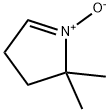| Description | Free radicals are highly reactive, short-lived species. Spin traps react with radicals, forming stable adducts that can be further studied. DMPO is a commonly-used spin trap that reacts with O-, N-, S-, and C-centered radicals. This allows their characterization when used in association with electron spin resonance and immuno-spin trapping. DMPO is water-soluble, rapidly penetrates lipid bilayers, has low toxicity, and can be used in vitro and in vivo. |
| Chemical Properties | white to faintly yellow solid |
| Uses | Spin trap agent for biological systems. |
| Uses | 5,5-Dimethyl-1-pyrroline N-oxide has been used as a spin trapping reagent to detect free radicals in electron paramagnetic resonance (EPR) based reactions. |
| Uses | 5,5-Dimethyl-1-pyrroline N-oxide is a reagent generally used either as a free-radical spin-trapping agent, or electrophilic component during the synthesis of pyrrolidine derivatives. It may also be considered as 1,3-dipole in cycloaddition processes. |
| Preparation | To a three-necked round bottom flask equipped with a condenser, addition funnel, thermometer, and mechanical stirrer and containing 300 ml. 95% ethanol precooled to 2°C is added, all at once, 14.5 g (0.1 mole) 4-methyl-4-nitropentanol, and 13.1 g (1.2 mole) zinc dust. With rapid agitation, the glacial acetic acid (24.0 g, 0.4 mole) is added dropwise over a 1-hr period while maintaining the reaction temperature below 15°C. The mixture is stirred vigorously for 2 hr and then stored in the refrigerator for 2 days, at approximately 1°C. Then the zinc acetate is filtered and rinsed with 100 ml of ethanol. The combined ethanol factions are rotoevapo-rated to give the crude nitrone. The crude nitrone is dissolved in a 200 ml portion of dichloromethane and the latter washed two times with saturated sodium bicarbonate solution. The organic layer is dried over sodium sulfate and the solvent rotoevaporated, to give 10.7 (94% yield) of the crude nitrone. The product was purified by double distillation (b.p. 53°C, 0.1 Torr), to give 6.8 g (60%) of the pure nitrone as a white hygroscopic solid. The H1 NMR (400 MH CDC13, Me4Si) is 6.80 (t, 2H, methylene bound to quaternary C, J = 7.2Hg), 1.43 (s, 6H, methyl), C13NMr (100 MH2, CDC13, Me4 Si) 5=132.4 (Vinyl), 73.5 (quaternary), 34.1 (Allyl), 25.3 (methylene bound to quaternary C), 24.4 (methyls). |
| Biological Activity | Water soluble nitric oxide spin trap; allows the measurement of oxygen-centered free radicals in biological systems at room temperature using electron spin resonance (ESR). Has a high reaction rate constant for superoxide and hydroxyl radicals, and distinguishes simultaneously among a variety of important biologically generated free radicals. |
| Physiological effects | 5,5-dimethyl-1-pyrroline N-oxide is used as a spin trap for the study of radicals formed by enzymatic acetaldehyde oxidation. It has a role as a neuroprotective agent and a spin trapping reagent. |
| References | 1) Nishizawa et al. (2004), Hydroxyl radical generation caused by the reaction of singlet oxygen with the spin trap DMPO, increases significantly in the presence of biological reductants; Mol. Pharmacol., 6 597
2) Shi et al. (2005), Evaluation of spin trapping agents and trapping conditions for detection of cell-generated reactive oxygen species; Arch. Biochem. Biophys., 437 59
3) Clement et al. (2005), Assignment of the EPR spectrum of 5,5-dimethyl-1-pyrroline-N-oxide (DMPO) superoxide spin adduct; J. Org. Chem., 70 1198
4) Gomez-Mejiba et al. (2009), Immuno-spin trapping of protein and DNA radicals: ‘tagging’ free radicals to locate and understand the redox process; Free Rad. Biol. Med., 42 530 |
